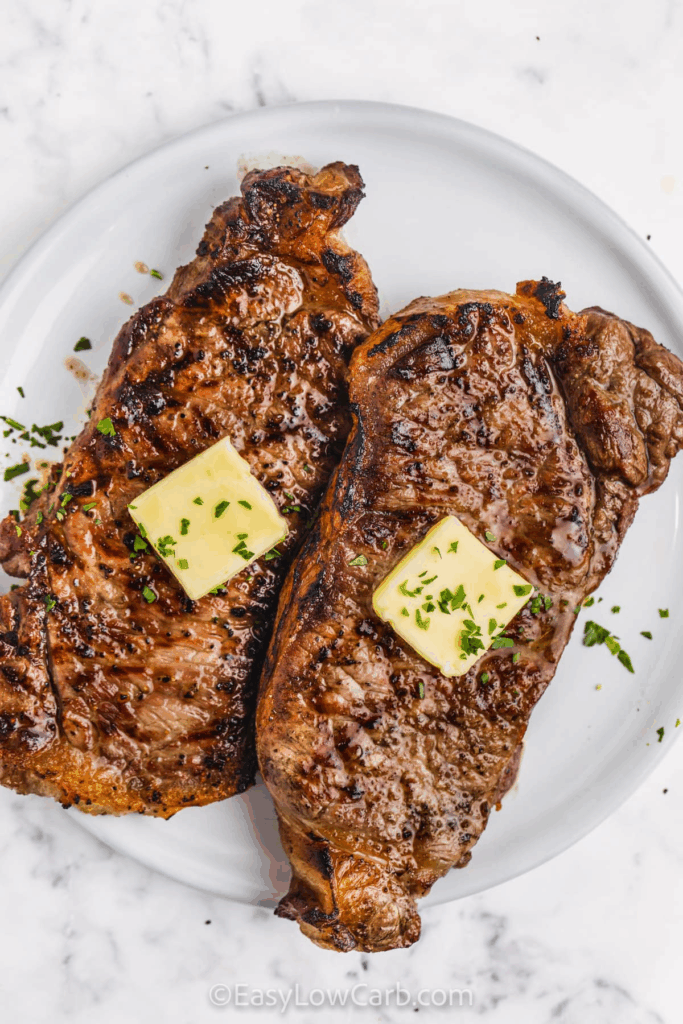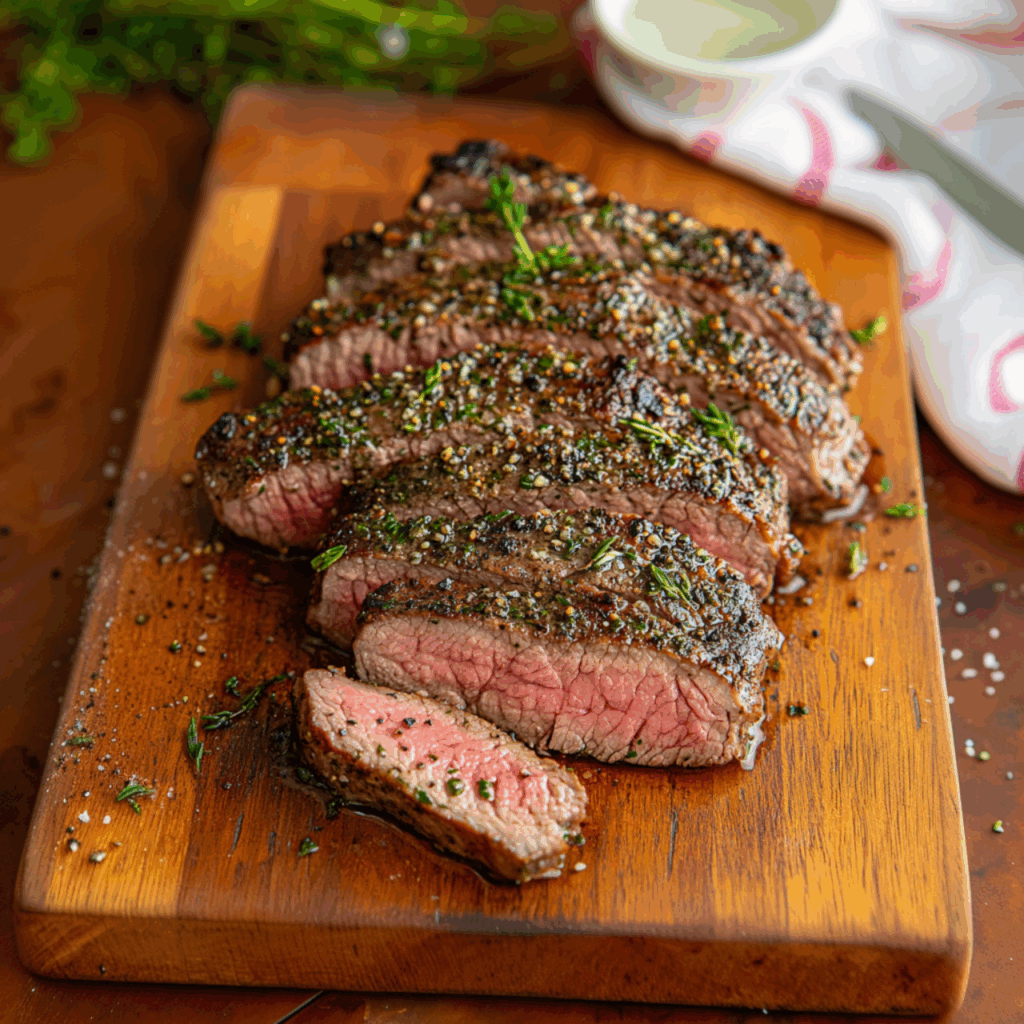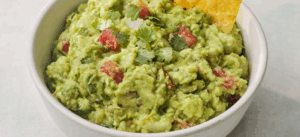How to Cook a Striploin Steak
How to Cook a Striploin Steak: A Chef’s Complete Oven, Skillet, and Grill Guide

Striploin steak is one of my personal favorites—rich, beefy, and incredibly satisfying when cooked right. Whether you’re aiming for a golden crust or a perfect pink center, this guide will walk you through every detail. Let’s take the guesswork out and make this steak shine, no matter what tools you’ve got.
- What Is Striploin Steak and Why It’s Special
- Choosing the Right Striploin Steak
- Preparing the Steak: Trimming and Drying
- Essential Ingredients and Tools
- How to Cook Striploin in a Skillet
- Oven Method for Striploin Steak
- Grilling Striploin Steak for Outdoor Flavor
- Internal Temperature Guide by Doneness
- Using a Pressure Cooker for Striploin Chunks
- Can You Microwave Striploin? (Only for Reheating)
- Sous Vide Striploin: Control and Precision
- Common Mistakes with Striploin Steak
- Best Sauces for Striploin Steak
- Seasoning Techniques for Maximum Flavor
- Serving and Pairing Striploin Like a Pro
- Storage and Reheating Without Ruining the Meat
- FAQ

What Is Striploin Steak and Why It’s Special
Striploin steak—also known as New York strip or sirloin strip—is a classic cut that balances flavor, tenderness, and structure. It comes from the short loin of the cow, near the top of the back, and is composed of a long, uniform muscle with a fine grain and a firm bite. When properly cooked, it delivers bold beefy flavor with just enough fat to stay juicy.
Striploin vs ribeye and tenderloin
Compared to ribeye, striploin has less marbling but a tighter, more even texture. It’s leaner and slightly firmer, which makes it ideal for a clean sear and neat slicing. Against tenderloin, it brings much more flavor, thanks to a modest fat cap and stronger beef profile. I reach for striploin when I want a steak that’s easy to cook, easy to serve, and reliably satisfying.
Why chefs love this cut
What I appreciate most is its versatility—it works beautifully in a skillet, on a grill, or with sous vide. It doesn’t demand the same attention as a ribeye and doesn’t dry out like cheaper cuts. It’s consistent, elegant, and delivers restaurant-level quality with minimal effort.
Choosing the Right Striploin Steak
Everything starts with the meat. A great striploin steak should look vibrant, smell fresh, and show clear marbling along the muscle. I take time selecting because no amount of technique can fix a low-quality cut.
Grass-fed vs grain-fed
Grass-fed beef tends to be leaner with a more mineral-forward flavor and tighter grain. Grain-fed, on the other hand, usually has better marbling and a richer mouthfeel. I use grass-fed for cleaner plates and grain-fed for indulgent results—both are great, but they behave differently on heat. Grain-fed tolerates high heat better due to its fat content, which caramelizes and protects the meat.
Thickness, marbling, and aging
I always choose steaks at least 1 to 1.5 inches thick. Thinner steaks overcook too quickly and don’t develop proper crust before the center is done. Look for visible marbling throughout—not just a fat strip on the edge—and avoid steaks that are oddly shaped or discolored. If you can find dry-aged striploin, you’ll get a deeper umami flavor and softer texture. Wet-aged works fine too but without that nutty intensity.

Preparing the Steak: Trimming and Drying
Once you’ve selected a quality striploin, prepping it properly is the key to nailing crust, doneness, and flavor. It’s not just about seasoning—it’s about setting the steak up to respond to heat the right way.
Should you remove the fat cap?
If the fat cap is more than ¼ inch thick, I trim it slightly but never remove it completely. It renders during cooking and bastes the steak, adding flavor and keeping the meat juicy. I also score the fat lightly with a knife to help it render evenly and prevent curling in the pan.
Why dry surface means better sear
A dry surface is essential. I take the steak out of the fridge 30–45 minutes before cooking and pat it dry thoroughly with paper towels. If I’m planning to dry-brine with salt, I do that up to 24 hours in advance and leave the steak uncovered on a rack in the fridge. This dries the surface and intensifies the flavor, giving me that golden crust every time.
Essential Ingredients and Tools
- Striploin steak (1–1.5 inches thick, preferably bone-off)
- Kosher salt
- Freshly cracked black pepper
- Neutral oil with a high smoke point (avocado, canola, grapeseed)
- Unsalted butter
- Garlic cloves
- Fresh thyme or rosemary
- Cast iron or stainless steel skillet
- Tongs
- Digital instant-read thermometer
- Aluminum foil
- Paper towels

How to Cook Striploin in a Skillet
Cooking striploin steak in a skillet is one of the most direct and rewarding methods. You get full control over the crust, heat, and finishing touches. I use a heavy cast iron pan because it retains heat and creates that deep golden sear you can’t fake.
Pan choice, heat control, crust building
I preheat the skillet over medium-high heat until it’s just starting to smoke. The key is to let the pan do the work—don’t rush it. Once the steak hits the surface, I don’t touch it for the first 2–3 minutes. This develops the crust. I then flip and sear the other side, adjusting the heat slightly down if needed to avoid burning. I continue flipping every minute or so for even browning and internal control.
When and how to add butter
After both sides are crusted, I lower the heat and add butter, smashed garlic, and fresh thyme or rosemary. I tilt the pan slightly and use a spoon to baste the steak with foaming butter for 30–60 seconds. This builds flavor and helps finish the steak gently. I remove the steak from the pan when it reaches 5°F (3°C) below my target doneness and rest it under foil.
Oven Method for Striploin Steak
The oven is ideal for consistent internal cooking—especially when paired with the reverse sear method. This technique slowly brings the steak to the desired internal temp before searing it for crust.
Reverse sear vs classic roast
With reverse sear, I roast the steak first in a low oven—250°F (120°C)—on a wire rack over a tray until it reaches 110–115°F (43–46°C) internal temp for medium-rare. Then I sear it quickly in a hot skillet to develop crust. This gives perfect edge-to-edge doneness and works beautifully with thick steaks.
For classic oven roast, I sear the steak in a pan first, then finish in a 375°F (190°C) oven until it reaches the desired internal temp. This works fine too but can result in less even doneness.
Best temperature and timing
Reverse searing takes about 25–35 minutes in the oven, then 2–3 minutes of searing. Classic sear-and-bake usually finishes in 6–8 minutes after the initial pan sear. I always rest the steak for at least 5–7 minutes before slicing to allow the juices to redistribute.

Grilling Striploin Steak for Outdoor Flavor
The grill adds char, smoke, and that unmistakable outdoor steakhouse quality. I use grilling when I want a deeper crust with a hint of flame flavor. It’s especially rewarding with thicker striploin cuts.
Direct vs indirect heat zones
I set up two zones: direct heat for searing and indirect heat for finishing. I start the steak over high heat—about 500°F (260°C)—for 2–3 minutes per side, then move it to indirect heat to finish slowly. This avoids burning and gives better control. I never press the steak—this squeezes out juices.
Basting and resting
Once the sear is done, I often brush the steak with melted butter or herb oil just before removing it from the grill. I use a digital thermometer to check doneness and pull it off 5°F below target temp. Resting is essential—I tent the steak loosely with foil for 10 minutes before serving.
Internal Temperature Guide by Doneness
I use these temperature targets in my kitchen, whether I’m cooking for guests or plating in a restaurant setting. The key is not just hitting the number—but also pulling the steak early to allow carryover cooking during rest.
| Doneness | Pull Temp (°F / °C) | Final Temp After Rest | Texture & Color |
| Rare | 115°F / 46°C | 120°F / 49°C | Cool red center, soft texture |
| Medium-rare | 125°F / 52°C | 130°F / 54°C | Warm red center, very juicy |
| Medium | 135°F / 57°C | 140°F / 60°C | Warm pink center, firm and juicy |
| Medium-well | 145°F / 63°C | 150°F / 66°C | Slightly pink, less moisture |
| Well-done | 155°F+ / 68°C+ | 160°F+ / 71°C+ | Fully brown, firm, drier texture |
I always use an instant-read thermometer and insert it from the side for the most accurate reading. Timing can vary depending on steak thickness and heat source, but temperature never lies.
Using a Pressure Cooker for Striploin Chunks
While I never use a pressure cooker for whole striploin steaks, it’s an excellent tool when I cube the meat for stews, rice bowls, or sauced dishes. Striploin is tender enough to hold its integrity under pressure, and it absorbs flavor well when surrounded by aromatics.
When I cube the steak
If I have trimmings or imperfectly shaped striploin cuts, I dice them into 1½- to 2-inch chunks, season with salt and pepper, and brown them using the sauté function in the pressure cooker. This browning builds flavor before any liquid is added.
Broth and aromatics
I then add beef broth, garlic, thyme, shallots, and a splash of soy sauce or Worcestershire. Cooking on high pressure for 20–25 minutes, followed by a natural release, gives me fork-tender, richly flavored steak pieces that are great over rice or mashed potatoes. The pressure cooker turns what could be scraps into a refined, melt-in-your-mouth meal.

Can You Microwave Striploin? (Only for Reheating)
I never cook raw striploin in the microwave—it doesn’t allow for searing or temperature control. However, it’s a valid option for reheating leftovers, especially sliced steak, if done correctly and gently.
Proper container and moisture tips
I always place sliced steak in a ceramic or glass dish with a splash of broth or butter. I cover it loosely with a lid or microwave-safe wrap to trap steam. This keeps the steak moist and prevents drying.
Power level and timing
I use 50% power, reheating in 30-second intervals, checking after each to avoid overheating. Depending on thickness, 1–2 minutes total is usually enough. I finish with a drizzle of butter, oil, or fresh lemon to revive flavor and texture. Microwaved steak is never quite the same, but done right, it can still be enjoyable.
Sous Vide Striploin: Control and Precision
Sous vide is my go-to when I want perfect doneness without stress. It’s especially effective for thick striploin steaks or when I’m hosting and need consistency across multiple portions. What makes sous vide unique is its ability to bring the entire steak to exactly the temperature you want—no guesswork, no overcooking.
Water bath setup
I season the steak with salt and pepper, then vacuum seal it with a small knob of butter and aromatics—usually thyme, crushed garlic, and lemon zest. I heat the sous vide bath to 129°F (54°C) for medium-rare. I submerge the bag and let it cook for 1.5 to 2 hours, depending on thickness. Even after 2 hours, the meat won’t overcook because the water never goes above the target temp.
Finishing in a hot skillet or torch
After cooking, I remove the steak from the bag, pat it completely dry with paper towels, and let it rest uncovered for a few minutes. I preheat a cast iron skillet until smoking hot and sear the steak for 45 seconds per side, including the edges. Alternatively, I use a culinary torch for the crust when I don’t want to reheat the center at all. The end result: precise temperature inside, perfect crust outside.
Common Mistakes with Striploin Steak
Even seasoned home cooks fall into traps with striploin—mostly due to haste or lack of prep. It’s a straightforward cut, but a few details can make or break it.
Overcooking, flipping too much, no resting
I’ve seen people ruin beautiful striploin by pushing it too far past medium. Striploin loses its natural juiciness and chew if taken beyond 145°F (63°C). I always remove it from heat 5°F before my goal temp and let it rest—carryover cooking handles the finish.
Another common error is constant flipping. Unless you’re doing minute-per-side turns for even browning, just let it sit undisturbed long enough to build crust. And never skip the resting period. A 5–10 minute rest allows juices to redistribute. Cut too soon, and you’ll lose flavor and moisture on the board.
Unseasoned surfaces or cold steak
Cooking a steak straight from the fridge results in uneven doneness. I always let it sit 30–45 minutes at room temperature before hitting the heat. And underseasoning is just as fatal. I season heavily with kosher salt and fresh pepper—surface-level seasoning isn’t enough. It needs time to interact with the meat, pull moisture, and set the crust.
Best Sauces for Striploin Steak
Striploin doesn’t need much—but when I want to impress or elevate the dish, a carefully chosen sauce completes the experience. I match the sauce to the mood: rustic, refined, or bold.
Pan sauce, compound butters, red wine reduction
After searing the steak, I pour off excess fat, then add a few tablespoons of finely chopped shallots and a splash of red wine or brandy. I reduce by half, add beef stock, and reduce again. A cold pat of butter swirled in at the end creates a silky texture.
For ease, compound butters are unbeatable. I blend softened butter with herbs, roasted garlic, lemon zest, or even crumbled blue cheese, then roll it in plastic wrap and chill. A slice melts over the hot steak and adds flavor with zero effort.
A red wine reduction with rosemary and Dijon creates a more formal, French-style finish. I serve it on the side or under the sliced steak so it doesn’t drown the crust.
Seasoning Techniques for Maximum Flavor
Seasoning is more than just salt—it’s timing, method, and balance. I adjust seasoning based on cooking method and steak thickness, always respecting the natural flavor of the meat.
Dry rubs, marinades, and crust building
For most methods, I go with a simple dry rub of kosher salt, coarsely ground black pepper, and optionally garlic powder or smoked paprika. I apply it generously at least 40 minutes before cooking, or up to 24 hours in advance if dry-aging in the fridge.
Marinades work for bold flavor profiles, like Korean BBQ or taco meat, but I keep it short—30–60 minutes max. Anything more, and the acid can damage the striploin’s texture.
Crust comes from dry surfaces and strong initial heat. Salt plays a role here by drawing out surface moisture, which evaporates during searing. I avoid wet seasonings unless I’m cooking sous vide or braising.
Salt timing and pepper considerations
I salt the steak early to draw moisture, which then reabsorbs, seasoning the meat deeper. For pepper, I grind it fresh just before cooking—fine enough to stick but coarse enough to hold its flavor. Burnt pepper is bitter, so I avoid putting it on too early if I’m grilling over flame.
Serving and Pairing Striploin Like a Pro
Striploin steak deserves thoughtful pairing and plating. I always consider contrast—rich steak needs acid, crunch, or freshness alongside it. That’s what makes the dish feel complete.
Sides, wine, and plating
For rich meals, I balance with light but flavorful sides: roasted root vegetables, garlicky greens, or creamy polenta. I avoid heavy starches unless I’m making it a full comfort dish. For wine, striploin pairs perfectly with bold reds—Cabernet Sauvignon, Syrah, Malbec, or even a Tempranillo if I’m going Mediterranean.
Plating-wise, I slice the steak against the grain, then fan it slightly on a warmed plate. I never pool sauce over the top—just a spoon around or underneath to let the crust remain intact. A touch of flaky salt and microgreens adds the final professional touch.
Slicing and presentation tips
I use a sharp slicing knife and clean between cuts. I angle the blade at about 30 degrees to show off the meat’s texture. I plate either sliced or as a whole piece for the diner to cut. If it’s family style, I pair it with a sauce on the side and serve with contrasting textures for balance.
Storage and Reheating Without Ruining the Meat
Even leftovers can be delicious if handled properly. Striploin holds up well for 1–2 days if stored and reheated correctly, though I always prefer it freshly cooked.
Refrigeration and freezing
I wrap leftover steak tightly in parchment and foil, or store in an airtight container with a paper towel to absorb moisture. In the fridge, it’s best within 2–3 days. For freezing, I slice it first, then portion into bags. This prevents ice crystals and allows quick thawing.
Reheating for texture, not toughness
To reheat, I use low heat in a skillet with a spoon of broth, butter, or jus. I cover with a lid to trap steam and warm it slowly. In the oven, I use 250°F (120°C), covered, for about 10–12 minutes.
For the microwave, only thin slices—and always at 50% power with added moisture and a cover. I finish with a little butter or lemon juice to revive the flavor. If it’s already sliced, I sometimes flash-sear the cold steak briefly for texture, especially in salads or tacos.
FAQ
What’s the ideal internal temperature for a striploin steak?
I recommend cooking striploin to 130°F (54°C) for medium-rare. That’s when the center is warm and pink, and the texture is juicy but firm. I remove it from heat around 125°F and let it rest—the carryover brings it right to the target without overcooking.
Should I cook striploin steak in a skillet or oven?
Both work, but I prefer a skillet for crust and control. The oven is better for thick steaks or when I’m using the reverse sear method. I’ve had great results with both, but for quick weeknight meals, I grab the pan first.
Can I grill striploin steak with the fat cap on?
Yes—and I recommend it. The fat adds flavor and moisture. Just make sure to place the fat side over indirect heat or trim it to about ¼ inch so it doesn’t cause flare-ups. I often score it slightly to help it render more evenly.
How long should I rest striploin steak after cooking?
I always rest striploin for at least 5–10 minutes. This lets the juices redistribute and gives a cleaner slice. If I skip this, even a perfectly cooked steak can bleed out on the plate and taste dry.
What’s the best way to reheat leftover striploin steak?
I reheat it gently in a skillet with a splash of broth or butter over low heat, or in a 250°F oven covered with foil. If I must use the microwave, I do 50% power in short bursts and add a bit of fat to revive texture.
Can I marinate striploin steak?
You can, but I rarely do unless I’m cooking it for tacos or stir-fry. Striploin already has good flavor and tenderness. If you do marinate, keep it under an hour and avoid acidic blends that can break down the meat too much.
How thick should a striploin steak be?
1–1.5 inches is ideal. Thinner steaks overcook fast and don’t develop a proper crust. Thicker steaks are better for reverse sear or sous vide, and they’re easier to cook medium-rare without drying the edges.
What oil should I use for searing striploin?
I use high smoke point oils like avocado, grapeseed, or canola. Olive oil burns too easily at searing temps. Once I’ve got the crust, I add butter for flavor—but not at the start.
Can I freeze cooked striploin steak?
Yes. I let it cool, then wrap it tightly in parchment and foil before freezing in a bag. It holds up well for up to 2 months. I thaw overnight in the fridge before reheating slowly with moisture.
What sauce pairs best with striploin?
Pan sauce with red wine and butter is a classic, but compound butter is my go-to. It adds flavor without overpowering the steak. If I serve it with grilled vegetables or roasted potatoes, I often skip sauce and just finish with flaky salt.
How do I get a perfect crust on striploin?
Start with a dry surface, room-temp meat, and a ripping-hot skillet. Don’t move the steak for the first 2–3 minutes. I also use coarse salt and press lightly with tongs for full contact. The crust forms from heat + time—not pressure.
Can I use striploin in stir-fry or tacos?
Definitely. I slice it thin across the grain, sear quickly in a hot pan, and add to bowls, tacos, or wraps. It works especially well if I’ve got leftovers—it stays tender and flavorful when reheated with sauce or aromatics.
Is dry-aged striploin better than regular?
If you like concentrated flavor and softer texture, yes. Dry-aged striploin is nutty, beefy, and incredibly tender. It’s more expensive, but for special occasions, I absolutely recommend it. I cook it the same way—just with a bit more respect.
What seasoning do you use on striploin?
For 90% of cases: kosher salt and cracked pepper. If I want a twist, I add garlic powder, smoked paprika, or chili flake. But nothing too complex—the steak should speak for itself.
Do you ever sous vide striploin for guests?
Yes, especially when I want guaranteed consistency. It’s ideal for dinner parties or restaurants because I can cook steaks ahead of time and just sear before serving. Everyone gets the same doneness, and I never worry about overcooking.




Post Comment